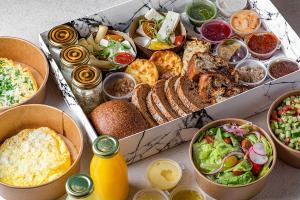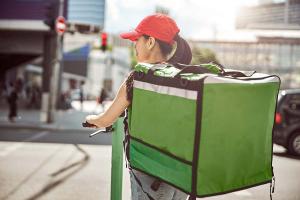How To Reduce Restaurant Delivery Costs
Restaurant industry delivery services, how they are affecting the restaurant industry, and how to reduce the high fees.
HOUSTON, TEXAS, UNITED STATES, June 22, 2022 /EINPresswire.com/ -- The explosive growth of online food ordering has also ushered in a new era of delivery services. In this new world, customers can enjoy the convenience of getting their favorite foods from any restaurant with a click. Delivery is available from almost any restaurant or fast-food chain, growing faster than ever. In fact, according to data compiled by Statista, the market for delivery services is expected to grow by more than 30% annually until 2023. Meanwhile, restaurants that provide delivery services are thriving. It makes up more than 20% of all food service establishments and generates $13 billion in annual sales. According to Bloomberg Second Measure, more than half of Americans have used meal delivery services, with the typical customer spending more than $200 in the first quarter of 2022.
Delivery fees are charged at a percentage-based rate on top of the standard transaction fee. The fees are usually applied to purchases made using a credit or debit card as the payment method. Delivery fees can range from 10-25 percent of the order amount. Fees are usually flat-rate, but some merchants may offer a discounted rate for purchases above a certain amount.
However, restaurants aren't exactly profitable with delivery fees included. As a result, the business usually ends up working at a loss unless it can slash its delivery fees and keep its margins intact after accounting for fixed costs such as driver wages, fuel costs, and insurance premiums.
Why Are Restaurant Delivery Fees So High?
The reason for high delivery fees is that restaurants make very little from delivery orders. Restaurants make considerably less from delivery orders compared to in-store sales. This is because the delivery fee is often a percentage of the total order amount. Delivery fees typically range from 10–25% of the total order value. This may seem like a small amount on a single order, but the numbers quickly add up when considering the volume of orders that most restaurants process daily. In fact, according to data compiled by Statista, the average delivery order value in the United States is $30. Therefore, if there is a delivery fee of 20%, that's an additional $6 on every order that is processed.
The profit margin of an in-store sale is usually significantly higher than that of a delivery sale. There are fixed costs associated with operating a delivery service. These include vehicle maintenance, fuel costs, insurance premiums, and employee wages. These costs are usually higher for delivery operations compared to in-store operations. This is because drivers making deliveries typically have to travel farther than employees working in the restaurant. As a result, delivery vehicles require more fuel than those used at the restaurant.
What are the costs of food delivery services?
Food delivery services are excellent, but it does come with a cost. Most services charge a percentage of the total price of the order, have a minimum order amount, and even fuel surcharges(https://www.fool.com/the-ascent/personal-finance/articles/ordering-food-delivery-watch-out-for-this-new-fee/). Furthermore, taxes and benefits must also be paid to delivery drivers. Depending on how often orders happen and the average cost of the meals, the delivery service cost can quickly add up. These additional costs increase the overall cost of running a delivery service.
The current fuel crisis is a global issue and the most significant cost added to the delivery. Americans may have it easy compared to many other countries. For example, drivers in Canada pay close to $7 (USD) a gallon, and the petrol in the U.K. is over $8 (USD). However, countries worldwide are experiencing significant shortages or complete shutdowns of their fuel production facilities. This has been caused by various factors, including refinery shutdowns, natural disasters, and geopolitical tensions. All these factors go into the final delivery costs.
These costs can also vary depending on the delivery service. For example, some services charge a flat fee for each delivery. Others charge a percentage-based fee, a minimum fee, or a combination of the three.
What factors influence the cost of restaurant delivery?
Many factors go into influencing the cost of restaurant delivery. Everything from food, fuel, and time to deliver is being billed and adding to the cost of every delivery.
Drivers who work for food delivery apps are responsible for paying for their gas, an expense that has risen dramatically over the past year. As a result, what was once able to be covered in one to two daily trips has increased to five or six to cover a day's worth of fuel for most delivery drivers.
Food prices(https://tbrnewsmedia.com/legislators-take-bite-out-of-rising-food-prices/) have also gone up drastically in the last year alone. A May report from the U.S. Bureau of Labor Statistics indicates food prices have climbed 10.8% since April 2021, the highest 12-month increase over four decades. The nationwide surge in food prices is being driven by several factors occurring domestically and abroad.
"Food prices in the United States are going up because the oil to deliver the food, the cost of fertilizer and the cost of planting and harvesting are all going up. All of that has to do with inflation, it has to do with oil and gas, and it has to do with the war in Ukraine." Martin Cantor, director of the Long Island Center for Socio-Economic Policy, said in a phone interview. (https://tbrnewsmedia.com/legislators-take-bite-out-of-rising-food-prices/)
The distance to the customer also will take into account. The farther away from the customer's restaurant, the higher the delivery cost will go up, not only for them but also for the restaurant itself. Everything from fuel, disposable takeout containers, and the driver's time will be incorporated into the fee.
Strategies to Reduce the Cost of Food Delivery
Delivery operations are critical to the success of a food delivery business. Many businesses use various methods to optimize these operations. First, ensure the delivery service offers a flat rate for deliveries rather than a percentage. This will make the delivery cost easier to control and adjust the menu pricing accordingly. Second, ensure only to deliver items where the delivery cost exceeds the order cost. No business wants to make deliveries that end up losing money because the extra fees take out any profit there may have been.
There are ways to save money with delivery by negotiating a lower rate with a delivery provider, increasing the minimum order value required to qualify, or offering delivery exclusively on certain days of the week. These options will help keep costs down when the business is not operating at peak efficiency. In addition, some places focus on delivery during off-peak hours and choose services that offer tip-based delivery. These help restaurants keep up with the rising delivery costs without outright refusing to deliver.
Food Delivery Storage Suppliers
Food Safety storage and transportation regulations change frequently, so it is essential to stay current on the latest best practices for storing and shipping food products. This will help to ensure that customers receive a high-quality product and the business remains compliant with government regulations. Food storage and transport products are specifically designed for the safe and efficient storage and transportation of perishable foods.
These products are often designed with features that keep foods at the ideal temperature for extended periods. The storage containers may also be designed to be compatible with other food handling equipment. Food transport and storage products may be available in various designs, sizes, and materials depending on their intended use. Some common examples of food storage and transport products include insulated food carriers, ice transport buckets, carts, and shelves. Restaurantsupply.com is a top-rated supplier of food storage and transport products. One of the oldest and most trusted restaurant supply e-commerce stores with more than 10,00 products in stock.
Some standard Food Storage and Transport products are:
Food Storage Supplies (https://www.restaurantsupply.com/storage-and-transport/food-storage-supplies) -
There are various food storage supply options on the market, including plastic canisters, glass canisters, plastic buckets, and metal buckets. Plastic buckets are less expensive but are not as durable as metal buckets and will break down over time. Plastic and glass canisters make great options for long-term food preservation because it's airtight, which helps to prevent spoiling. Metal buckets are best for storing perishable items because the buckets are conductive and help to prevent food from spoiling too quickly.
Carts (https://www.restaurantsupply.com/carts)-
Food transport carts are typically used to move food from one location to another. Some examples of these carts include a pushcart, a small shopping cart with a basket, a food service cart, and a utility cart. Push carts are often used by people who are out and about and want to transport their items with them. Foodservice carts are typically used in large-scale food service operations, such as school cafeterias or large restaurants. Finally, utility carts are often used to haul materials on a construction site, load and unload materials from a truck, or move supplies from one location to another.
Restaurant Shelving(https://www.restaurantsupply.com/restaurant-shelving) -There are two main types of restaurant shelving: modular and fixed. Modular shelving is easier to install and can be rearranged to fit the inventory. Fixed shelving is usually built-in and cannot be moved, but it is often more durable and less expensive than modular shelving. The restaurant shelving chosen will depend on the inventory, layout, and budget.
Storage Racks(https://www.restaurantsupply.com/storage-racks) - There are many types of racks available, including open and enclosed styles. Open racks are the most common type. Usually used to store small items like parts, hardware, or small tools. Available racks are typically mounted from the ceiling or the walls. The open racks can be fixed or adjustable. These racks are usually mounted from the floor.
Dinnerware Storage and Transport (https://www.restaurantsupply.com/dinnerware-storage-and-transport) -
If transporting the dishes from one location to another, make sure it's done it correctly. Plates are fragile and will break if the plates are dropped. However, transport kits can help keep dishes safe while transporting them. These can be anything from bus tubs and flatware bins to glass and dish racks.
Insulated Food Carriers and Beverage Dispensers(https://www.restaurantsupply.com/restaurant-food-storage-and-transport) - An insulated food carrier is a type of container used to keep food hot or cold for an extended period of time. These large boxes are designed to keep pans of food held at temperature. Most of these will come with wheels and handles for easy transport. The carriers come in a variety of sizes and dimensions to fit any need. Beverage dispensers are refrigerators that serve as a source of cold beverages for guests. These are easily transportable and come with wheels for easy maneuverability.
Insulated Food Delivery Bags (https://www.restaurantsupply.com/storage-and-transport/insulated-food-delivery-bags) -
Insulated food delivery bags are specially designed to keep food hot or cold for a more extended period of time. The bags are available in various styles and materials, so it's easy to find one that works best for the business's needs. Most insulated food delivery bags are made with fabric-lined insulation. Fabric options include neoprene, nylon, and polyester. There are two main insulated food delivery bags: those with a removable liner and those with a non-removable liner. The non-removable liner bags are ideal for freezing. The removable liner options are best for keeping food warm.
Food Delivery Bag Accessories(https://www.restaurantsupply.com/storage-and-transport/food-delivery-bag-accessories) - Food delivery bags are the bags that are used to carry the food from the place where it is cooked to the site where it is to be consumed. Food delivery bag accessories are the parts that can be added to a standard food delivery bag to make its use more accessible and more convenient. For example, a traditional food delivery bag might not have a high handle enough to allow a person to carry it above their head easily. Additional pockets can be added to a bag to make it easier to organize items. Velcro can be added to the inside of a bag to allow the addition of name tags for easy identification of the bag when multiple people in a workplace use them. Additional clasps or straps can be added to a bag to make it easier to close and seal. And many other things can be added to a bag to make its use more manageable and convenient.
Trucks and Dollies (https://www.restaurantsupply.com/trucks-and-dollies)-
Food trucks and dollies are often used to transport perishable foods like fruits and vegetables, frozen foods, and liquid foods like milk from one location to another. The foods are loaded into trucks or dollies and transported to their destination, where the products are unloaded and stocked.
Ice Transport Buckets and Mobile Bins (https://www.restaurantsupply.com/storage-and-transport/ice-transport-buckets-and-mobile-ice-bins) -
These are the most common options for transporting and storing ice. Ice buckets come in a variety of sizes and have a removable lid. The buckets are commonly made of plastic but can also be stainless steel. Mobile bins are the best option for transporting smaller quantities of ice. Mobile bins are large bins on wheels that can hold up to 3,500 lbs of ice. Often made of stainless steel or plastic. The bins are the best option for storing larger quantities of ice.
Casters, Leg Kits, and Accessories(https://www.restaurantsupply.com/casters-leg-kits-and-accessories)- Various caster options are available to suit the business's needs. For example, heavy-duty casters are durable and ideal for moving large pieces of equipment. Stem casters are designed for a smooth, quiet glide. Swivel casters allow ease of movement. Caster wheels are also convenient if there is a need to move the equipment frequently.
Recommendations for Restaurants Using Delivery Services
Most restaurants use delivery services that add on average 30% to costs, so how to decrease your costs and keep restaurant profits?
- Purchase delivery equipment and run delivery services in-house
- Use flat-rate delivery services
- Negotiate a lower rate with the delivery provider
- Increase the minimum order value required for delivery
- Offer delivery exclusively on certain days of the week
Nowadays, it's not surprising to see delivery offered by almost every restaurant, using their online ordering system or app to order food. Most of these delivery services let customers order food from any restaurant, but delivery services are only as good as the restaurants it works with, so do the research. Every business has to have the proper storage and transport equipment(https://www.restaurantsupply.com/storage-and-transport) for delivery, such as a warming drawer to hold food and ensure the staff has the appropriate training for delivering food.
The delivery partner is responsible for picking up the order from the restaurant and delivering it to the customer's location. Choosing the right partner is critical to slashing the delivery costs. Choose a partner that offers the best value in terms of price and service. The delivery terms include the number of orders per day, the minimum order amount, the delivery fee, and the distance the driver can travel. Negotiate these terms with the delivery partner to get a better deal.
Sabina
Restaurantsupply.com
sabina@restaurantsupply.com
How to start a meal prep business
Legal Disclaimer:
EIN Presswire provides this news content "as is" without warranty of any kind. We do not accept any responsibility or liability for the accuracy, content, images, videos, licenses, completeness, legality, or reliability of the information contained in this article. If you have any complaints or copyright issues related to this article, kindly contact the author above.




